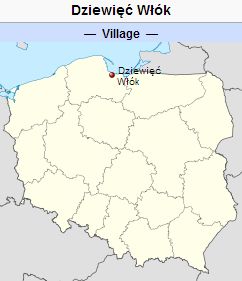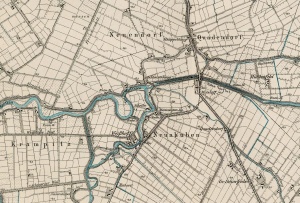Difference between revisions of "Neunhuben (Pomeranian Voivodeship, Poland)"
| [unchecked revision] | [checked revision] |
GameoAdmin (talk | contribs) (CSV import - 20130816) |
AlfRedekopp (talk | contribs) |
||
| (3 intermediate revisions by 2 users not shown) | |||
| Line 1: | Line 1: | ||
| − | + | [[File:Neunhuben%20Danzig.jpg|300px|thumb|right|''Neunhuben (now Dziewięć Włók, Poland) | |
| − | Source: [http://en.wikipedia.org/wiki/Dziewięć_Włók,_Gdańsk_County Wikipedia Commons] | + | Source: [http://en.wikipedia.org/wiki/Dziewięć_Włók,_Gdańsk_County Wikipedia Commons]'']] [[File:Neunhuben%20Pomeranian%20Voivodeship%201916.jpg|300px|thumb|right|''Detailed map of Neunhuben in 1916 |
| − | + | Source: [http://amzpbig.com/maps/1678_Weichselmunde_1916.jpg Archiwum Map Zachodniej Polski]'']] Neunhuben (also known as Neuenhuben, Nassehuben, and Nicponie; now known as Dziewięć Włók; coordinates: 54.3097, 18.7325 [54° 18′ 34″ N, 18° 43′ 57″ E]; population in 1905, 46; in 2012, 147) is located approximately 8 kilometres (5 miles) north-east of Pruszcz Gdański (Praust) and 6 km. (4 mi.) south-east of the regional capital Gdańsk ([[Danzig (Poland)|Danzig]]). | |
| − | |||
| − | Source: [http://amzpbig.com/maps/1678_Weichselmunde_1916.jpg Archiwum Map Zachodniej Polski] | ||
| − | |||
| − | '']] Neunhuben (also known as Neuenhuben, Nassehuben, and Nicponie; now known as Dziewięć Włók; coordinates: 54.3097, 18.7325 [54° 18′ 34″ N, 18° 43′ 57″ E]; population in 1905, 46; in 2012, 147) is located approximately 8 kilometres (5 miles) north-east of Pruszcz Gdański (Praust) and 6 km. (4 mi.) south-east of the regional capital Gdańsk ([[Danzig (Poland)|Danzig]]). | ||
Neunhuben was founded in the 16th century by Dutch settlers. Until 1772 Neunhuben was located in what was known as Royal Prussia (also known as Polish Prussia) in the Kingdom of Poland. The First Partition of Poland in 1772 resulted in the creation of a new province in 1773, called West Prussia, in which Neunhuben was located. Neunhuben was situated in the district (Kreis) of Danzig from 1818 until 1887, when it became part of the district of Danziger Niederung. Neunhuben became part of the Free City of Danzig from 1920 until the outbreak of World War II in 1939, when it came under the control of Nazi Germany. In February 1945 it was occupied by Soviet forces and eventually returned to Poland. In 2012 Neunhuben (now Dziewięć Włók) was a village in the administrative district of Gmina Pruszcz Gdański, within Gdańsk County, Pomeranian Voivodeship. | Neunhuben was founded in the 16th century by Dutch settlers. Until 1772 Neunhuben was located in what was known as Royal Prussia (also known as Polish Prussia) in the Kingdom of Poland. The First Partition of Poland in 1772 resulted in the creation of a new province in 1773, called West Prussia, in which Neunhuben was located. Neunhuben was situated in the district (Kreis) of Danzig from 1818 until 1887, when it became part of the district of Danziger Niederung. Neunhuben became part of the Free City of Danzig from 1920 until the outbreak of World War II in 1939, when it came under the control of Nazi Germany. In February 1945 it was occupied by Soviet forces and eventually returned to Poland. In 2012 Neunhuben (now Dziewięć Włók) was a village in the administrative district of Gmina Pruszcz Gdański, within Gdańsk County, Pomeranian Voivodeship. | ||
| Line 16: | Line 12: | ||
In 1675, Neunhuben had eight Mennonites, in 1725, six, and in 1748 also six. The 1776 Prussian census lists three Mennonite families in Neunhuben with the following surnames: Conrad, Penner, and Suckau. At the end of the 19th century, the congregation included 30 families and in 1941, 67 members. | In 1675, Neunhuben had eight Mennonites, in 1725, six, and in 1748 also six. The 1776 Prussian census lists three Mennonite families in Neunhuben with the following surnames: Conrad, Penner, and Suckau. At the end of the 19th century, the congregation included 30 families and in 1941, 67 members. | ||
| − | |||
| − | |||
= Bibliography = | = Bibliography = | ||
Schapansky, Henry. <em>Mennonite Migrations (and the Old Colony, Russia)</em>. New Westminster, BC: Henry Schapansky, 2006: 126. | Schapansky, Henry. <em>Mennonite Migrations (and the Old Colony, Russia)</em>. New Westminster, BC: Henry Schapansky, 2006: 126. | ||
| Line 25: | Line 19: | ||
Wikipedia. "Dziewięć Włók, Gdańsk County." Web. 23 December 2012. [http://en.wikipedia.org/wiki/Dziewięć_Włók,_Gdańsk_County http://en.wikipedia.org/wiki/Dziewięć_Włók,_Gdańsk_County]. | Wikipedia. "Dziewięć Włók, Gdańsk County." Web. 23 December 2012. [http://en.wikipedia.org/wiki/Dziewięć_Włók,_Gdańsk_County http://en.wikipedia.org/wiki/Dziewięć_Włók,_Gdańsk_County]. | ||
| − | Wolf, Hans-Jürgen. "Familienforschung in Westpreußen." Web. | + | Wolf, Hans-Jürgen. "Familienforschung in Westpreußen." Web. 22 June 2020. http://www.westpreussen.de/pages/forschungshilfen/ortsverzeichnis/details.php?ID=4703. |
| − | |||
| − | |||
= Maps = | = Maps = | ||
[[Map:Dziewięć Włók, Pomeranian Voivodeship, Poland|Map:Dziewięć Włók, Pomeranian Voivodeship, Poland]] | [[Map:Dziewięć Włók, Pomeranian Voivodeship, Poland|Map:Dziewięć Włók, Pomeranian Voivodeship, Poland]] | ||
{{GAMEO_footer|hp=|date=August 2013|a1_last=Thiessen|a1_first=Richard D|a2_last=|a2_first=}} | {{GAMEO_footer|hp=|date=August 2013|a1_last=Thiessen|a1_first=Richard D|a2_last=|a2_first=}} | ||
| + | [[Category:Cities, Towns, and Villages]] | ||
| + | [[Category:Cities, Towns, and Villages in Poland]] | ||
Latest revision as of 01:50, 23 June 2020


Neunhuben (also known as Neuenhuben, Nassehuben, and Nicponie; now known as Dziewięć Włók; coordinates: 54.3097, 18.7325 [54° 18′ 34″ N, 18° 43′ 57″ E]; population in 1905, 46; in 2012, 147) is located approximately 8 kilometres (5 miles) north-east of Pruszcz Gdański (Praust) and 6 km. (4 mi.) south-east of the regional capital Gdańsk (Danzig).
Neunhuben was founded in the 16th century by Dutch settlers. Until 1772 Neunhuben was located in what was known as Royal Prussia (also known as Polish Prussia) in the Kingdom of Poland. The First Partition of Poland in 1772 resulted in the creation of a new province in 1773, called West Prussia, in which Neunhuben was located. Neunhuben was situated in the district (Kreis) of Danzig from 1818 until 1887, when it became part of the district of Danziger Niederung. Neunhuben became part of the Free City of Danzig from 1920 until the outbreak of World War II in 1939, when it came under the control of Nazi Germany. In February 1945 it was occupied by Soviet forces and eventually returned to Poland. In 2012 Neunhuben (now Dziewięć Włók) was a village in the administrative district of Gmina Pruszcz Gdański, within Gdańsk County, Pomeranian Voivodeship.
A Flemish Mennonite congregation was initially established in Neunhuben in 1659 and was subsequently integrated into the Danzig congregation. In 1768 this group, finding the roads to the Danzig city church impassable, requested that occasional services be held among them; this was feasible, for two of the preachers lived in the Werder. In 1791 Neunhuben became independent of the city church, except that the elder of the city congregation had the oversight over them. In 1826, when the Danzig city congregation engaged a salaried elder, the Werder congregation broke away and became a subsidiary of the Fürstenwerder church. In 1844 they built a small church at nearby Quadendorf and have since been known by the Neunhuben name.
Ministers in Neunhuben included Kornelius Epp (1728-1805), minister from 1790 to 1805, Jacob Kröcker (b. 1759), elected minister in 1791, Jacob Bartsch (b. 1761), minister from 1791 to 1801, Johann Töws (b. 1767), elected minister in 1797, Klaas Reimer (1770-1837), elected minister in 1801 and served until his immigration to Russia in 1804, and Heinrich Wiebe (b. 1765), minister from 1804 until his resignation in 1820.
In 1675, Neunhuben had eight Mennonites, in 1725, six, and in 1748 also six. The 1776 Prussian census lists three Mennonite families in Neunhuben with the following surnames: Conrad, Penner, and Suckau. At the end of the 19th century, the congregation included 30 families and in 1941, 67 members.
Bibliography
Schapansky, Henry. Mennonite Migrations (and the Old Colony, Russia). New Westminster, BC: Henry Schapansky, 2006: 126.
Stowarzyszenie Konserwatorów Zabytków. "Dziewięć Włók." Catalogue of Monuments of Dutch Colonization in Poland. 2005. Web. 23 December 2012. http://holland.org.pl/art.php?kat=obiekt&id=317&lang=en.
Wikipedia. "Dziewięć Włók, Gdańsk County." Web. 23 December 2012. http://en.wikipedia.org/wiki/Dziewięć_Włók,_Gdańsk_County.
Wolf, Hans-Jürgen. "Familienforschung in Westpreußen." Web. 22 June 2020. http://www.westpreussen.de/pages/forschungshilfen/ortsverzeichnis/details.php?ID=4703.
Maps
Map:Dziewięć Włók, Pomeranian Voivodeship, Poland
| Author(s) | Richard D Thiessen |
|---|---|
| Date Published | August 2013 |
Cite This Article
MLA style
Thiessen, Richard D. "Neunhuben (Pomeranian Voivodeship, Poland)." Global Anabaptist Mennonite Encyclopedia Online. August 2013. Web. 23 Nov 2024. https://gameo.org/index.php?title=Neunhuben_(Pomeranian_Voivodeship,_Poland)&oldid=168507.
APA style
Thiessen, Richard D. (August 2013). Neunhuben (Pomeranian Voivodeship, Poland). Global Anabaptist Mennonite Encyclopedia Online. Retrieved 23 November 2024, from https://gameo.org/index.php?title=Neunhuben_(Pomeranian_Voivodeship,_Poland)&oldid=168507.
©1996-2024 by the Global Anabaptist Mennonite Encyclopedia Online. All rights reserved.